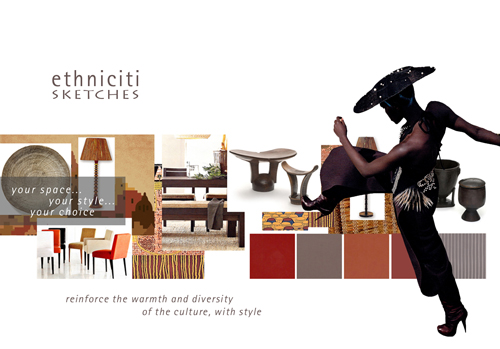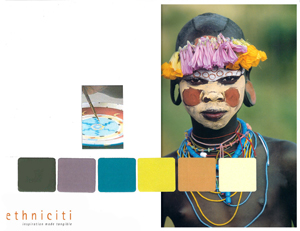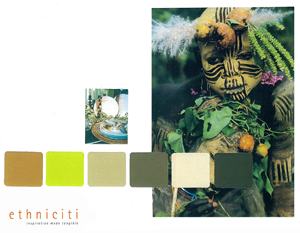Communal ties – color as unifier
According to Benjamin Moore’s Color Pulse 2011 as reported by Home Accents Today, “Color represents community as the great unifier and hopeful sign of renewal. Thanks to technology and advancements in communications, we are a much more tight-knit world of ethnic, social and cultural beings. What once might have seemed exotic and foreign is easily familiar. The scale is not tipping in favor of one hemisphere over another; it is finding balance in our acceptance and respect for one another, the animal and plant life around us and our overall environment.”
The human body as design element
Benjamin Moore’s palette titled Tribe reflects a new sense of unity where the mindset of “me'” morphs into “we.” “The human body becomes a design element, highlighting the importance of caring for others,” the Color Pulse States. “Respect for animals is reflected by the need to preserve and protect. Ritual symbols and primitive design are translations of tribal ways, as we rebuild cultures and respect nature’s precious creatures. Global ethnic influences become localized.”
In Tribe, bronze “warms the cultural landscape to continue with the vibrancy of layered and rich hues,” the Color Pulse states. “African, Eurasian, and Latino borrow nuances from many cultures to commune in a harmonic color space.”
Multi-ethnic looks become world style
Tribe’s color palette includes galaxy, flame, sierra spruce, rosy blush, bronze metallic, juniper, dark burgundy, Sun Valley, butterscotch, and Brazilian blue. In terms of texture and pattern, handwork, patchwork, pattern-on-pattern, animal prints, maps, and African textures and prints are trend right.
Multi-ethnic looks continue because people now can see how products and clothing really look in other parts of the world, enabling those looks to become part of Western society.
Pantone’s Fragments palette represents a compilation of varying cultures from all over the globe. “Fragments picks up pieces of diverse places and weaves them into an integrated whole. Carpets, found tables, ornament beads, and even discarded bottle caps destined for the landfill are cleverly joined together to form an electrically colored patchwork of amberglow, grenadine, strawberry pink, baked clay, dark citron, concord grape, cadmium green, and bright gold.”

The Trend Curve’s Tribal Wisdom palette explores the continuation of the global trend, resulting in Mayan, Incan, and Hopi tribal influences. The art and architecture of ancient cultures comes into play as geometric florals, ikats, trapezoids, and primitive portrayals of the sun arise. Shades in Tribal Wisdom embrace brown, coral, caramelized gold, lush green, and red-cast purple.

Contact Home Accents Today to receive the 2011 Color Forecast.
 Always looking to advance the notion of the connection of apparel to home fashion, we have created a series of ethniciti Sketches that form the basis of our online interior design service.
Always looking to advance the notion of the connection of apparel to home fashion, we have created a series of ethniciti Sketches that form the basis of our online interior design service. We are interested in how you might approach the design of of African-inspired interior spaces. Send us your ideas: ethniciti@aol.com.
We are interested in how you might approach the design of of African-inspired interior spaces. Send us your ideas: ethniciti@aol.com. Let ethniciti inspire your room makeovers in our unique, African-inspired style.
Let ethniciti inspire your room makeovers in our unique, African-inspired style.























